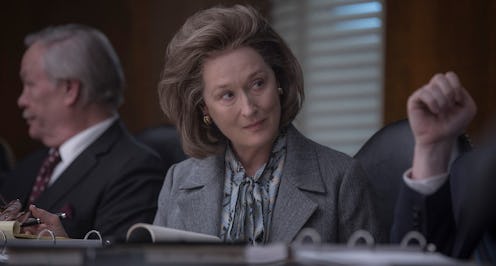Entertainment
Here's The REAL Story Of The Badass Lady Meryl Streep Plays In 'The Post'

Has there ever been a movie with more prestige than The Post? The film is directed by Steven Spielberg, stars Meryl Streep and Tom Hanks, and depicts an actual landmark historical event, the printing of the Pentagon Papers by the Washington Post. Between its plot, director, and two leads, the movie has "multiple Oscar winner" written all over it, but perhaps the person from the film who's drawing the most praise is Streep, who portrays Kay Graham — the United States' first female newspaper publisher. But what happened to the real Kay Graham from The Post?
Sadly, Graham passed away in 2001 at the age of 84 after injuring her head in a fall, but only after living a seriously inspiring and accomplished life. Born in 1917, Graham didn't initially set out to be a publishing trailblazer or a journalistic legend, but that's essentially what happened along the way. Her father, Eugene Meyer, purchased the Washington Post in 1933 and also acted as its publisher until he handed over those duties of the paper to his daughter's husband, Phillip Graham, in 1946. Then upon Meyer's death in 1959, Phillip took over full control of the the Washington Post Company, while Katharine Graham's involvement at the paper was basically nonexistent. This would soon change in a major way.
In 1963, Kay was a housewife with four children who was pushing 50 when her husband began a rapid mental decline. Suffering from an undiagnosed case of manic depression, Phillip Graham began an affair with a younger woman, had a very public meltdown, and then killed himself, according to The Guardian. His death put Katharine in the unexpected position of leading the paper and taking control of the company, which she did in an unofficial capacity at first before officially becoming president of the company in 1967, publisher of the paper in 1969, and chairwoman of the company's board in 1973. During this time period, she became the first female publisher of a U.S. newspaper and the first woman to lead a Fortune 500 company. She also served as the first female director of the Associated Press, according to the Washington Post.
During Graham's reign as publisher of the Post, a position she held until 1979, the paper forged through two events that cemented its status as a journalistic institution. The first event, and the one that is dealt with in Spielberg's The Post, was the publishing of the Pentagon Papers in 1971. These documents contained the U.S. government's secret history of the war in Vietnam, and the government — who had lied to Congress and the public about the war — sought to keep the paper from publishing them. The case went all the way to the Supreme Court, where it was ruled that the Post — along with the New York Times, who also ran stories on the Pentagon Papers — were allowed to publish the documents. The other big moment for which Graham is remembered is the work she greenlit on the Watergate case. Washington Post reporters Bob Woodward and Carl Bernstein — under Graham's leadership — exposed the truth about the Watergate scandal that helped bring about the resignation of President Richard Nixon in 1974.
In addition to her legendary work on the publishing side of the Post, Graham is arguably even more accomplished on the business side of things. Under her leadership, the Washington Post Company grew twenty times larger, according to the Post, and she transformed the company from a family-run business into a massive public media conglomerate with a listing on the New York Stock Exchange.
The Post tells only a sliver of the unimaginably impressive life of Kay Graham, but anyone who sees the film will still no doubt end up being inspired by this amazing woman.